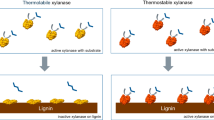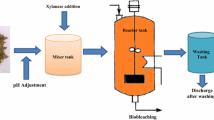Abstract
Xylanase A (XylA) from Pseudomonas fluorescens subsp. cellulosa consists of an N-terminal non-catalytic cellulose-binding domain joined to a functionally independent C-terminal catalytic domain by a sequence rich in serine residues. Xylanase D (XylD) from Cellulomonas fimi also exhibits a modular structure comprising an N-terminal catalytic domain linked to an internal non-catalytic xylan-binding domain and a C-terminal cellulose-binding domain. To determine the importance of the non-catalytic polysaccharide-binding domains and linker sequences of XylA and XylD in relation to their capacity to hydrolyse pulp xylan and enhance bleachability, purified full-length and modified derivatives of both enzymes were incubated with a hardwood kraft pulp. Deletion of the cellulose-binding domain or linker region from XylA decreased the activity of the enzyme against pulp xylan, but had no significant effect on the capacity of the enzyme to facilitate delignification and reduce pulp kappa number. While full-length and truncated forms of XylD, lacking either the cellulose-binding or the cellulose- and xylan-binding domains, were equally effective in hydrolysing pulp xylan, enzyme derivatives containing a polysaccharide-binding domain were marginally more efficient in reducing pulp kappa number. The reduction in kappa number elicited by full-length and isolated catalytic domains of XylA and XylD was reflected in an increase in the brightness of paper handsheets derived from pretreated pulps. Thus, the polysaccharide-binding domains of XylA and XylD did not appear to confer any advantage in terms of the ability of the enzymes to improve pulp bleachability. However, XylA and XylD, which belong to different glycosyl hydrolase families, differed in their ability to hydrolyse pulp xylan and facilitate the delignification of kraft pulp.
Similar content being viewed by others
Author information
Authors and Affiliations
Additional information
Received: 21 March 1996 / Received revision: 11 July 1996 / Accepted: 19 July 1996
Rights and permissions
About this article
Cite this article
Rixon, J., Clarke, J., Hazlewood, G. et al. Do the non-catalytic polysaccharide-binding domains and linker regions enhance the biobleaching properties of modular xylanases?. Appl Microbiol Biotechnol 46, 514–520 (1996). https://doi.org/10.1007/s002530050853
Issue Date:
DOI: https://doi.org/10.1007/s002530050853




